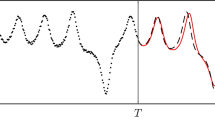Abstract
A pervasive task in decision making lies in the prediction of unknown phenomena. In the past, the majority of decision support tools has addressed linear phenomena or simple nonlinear tasks such as discriminatory analysis. However, recent advances in nonlinear theory and software techniques suggest the feasibility of developing generalized tools for analyzing nonlinear signals incorporating chaotic features. The goal of signal processing is to predict some aspect – whether temporal or spatial – of the underlying source. A temporal attribute is exemplified by the trajectory of an object, and a spatial characteristic by its shape. In the manufacturing environment, for instance, such predictive functions arise in the historical yield of a production line or the pattern of breakdowns. The primary functions of the proposed system are as follows: (1) forecasting the trajectory of signals, whether generated by an informational source such as a quality control center, or a physical source such as a tornado or a national economy, and (2) predicting spatial phenomena such as the location of a single object or the geographic dispersal of earthquakes. The feasibility of predicting the behavior of a single unit springs from the partial predictability of chaotic disturbances such as atmospheric turbulence in conjunction with the inertial properties of large objects such as vehicles. The practicality of predicting aggregate behavior derives from the limited dimensionality of interrelated systems, including cognitive and organizational processes in the context of numerous decision making agents. Nonlinear phenomena such as exponential decay, saturation effects, dead time, and precarious dependence on initial conditions, may be addressed by a number of modern computational techniques. Among these are the methods of chaotic analysis and declarative reasoning in conjunction with proven techniques such as Markov modeling and statistical forecasting. The integrated approach provides a systematic methodology for predicting chaotic signals despite environmental uncertainties and internal disturbances. A predictive system for chaotic processes is applicable to many sectors. The applications range from mobile robots to manufacturing plants; from navigation in ships to resource management in communication networks; and from biomedical signal processing to economic forecasting.
Similar content being viewed by others
Author information
Authors and Affiliations
Rights and permissions
About this article
Cite this article
Kim, S. Knowledge based prediction of nonlinear phenomena. Soft Computing 4, 113–122 (2000). https://doi.org/10.1007/s005000000043
Issue Date:
DOI: https://doi.org/10.1007/s005000000043




